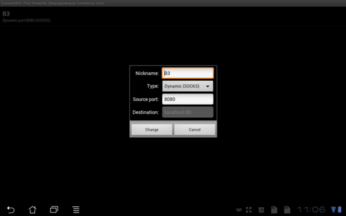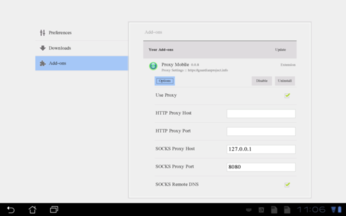SSH Tunneling on Android for Secure Web Browsing

Productivity Sauce
When you are on the move, you can easily secure your Internet connection by setting up an SSH tunnel, provided you have a remote SSH server to connect to. Creating an SSH tunnel on Linux is a matter of executing the ssh -ND 9999 user@remotehost command in the terminal. But what if you are using an Android device when you are out and about? ConnectBot has got you covered. This SSH client app can be used to set up an SSH tunnel by configuring a so-called port forward. To do this, launch ConnectBot and establish a connection to an SSH server.
Press then the Menu button and tap on Port Forwards. Press again Menu and tap on Add port forward. Give the new port forward a name, select Dynamic (SOCKS) from the Type list, and specify the desired source port (e.g., 8080), and press the Create port forward button. From now on, ConnectBot will automatically establish an SSH tunnel every time you connect to the remote SSH server.
To use the SSH tunnel you need a browser that supports proxy servers. To enable proxy support in the Mozilla Firefox browser for Android, you need to install the Proxy Mobile add-on. In Firefox, switch to the Add-ons section, search for Proxy Mobile and install the add-on. Restart the browser and switch to the add-on Options section. Enter 127.0.0.1 to the SOCKS Proxy Host field and 8080 to the SOCKS Proxy Port field. That's all there is to it. You can now browse the web through the established SSH tunnel.
Comments
comments powered by DisqusSubscribe to our Linux Newsletters
Find Linux and Open Source Jobs
Subscribe to our ADMIN Newsletters
Support Our Work
Linux Magazine content is made possible with support from readers like you. Please consider contributing when you’ve found an article to be beneficial.

News
-
Two New Distros Adopt Enlightenment
MX Moksha and AV Linux 25 join ranks with Bodhi Linux and embrace the Enlightenment desktop.
-
Solus Linux 4.8 Removes Python 2
Solus Linux 4.8 has been released with the latest Linux kernel, updated desktops, and a key removal.
-
Zorin OS 18 Hits over a Million Downloads
If you doubt Linux isn't gaining popularity, you only have to look at Zorin OS's download numbers.
-
TUXEDO Computers Scraps Snapdragon X1E-Based Laptop
Due to issues with a Snapdragon CPU, TUXEDO Computers has cancelled its plans to release a laptop based on this elite hardware.
-
Debian Unleashes Debian Libre Live
Debian Libre Live keeps your machine free of proprietary software.
-
Valve Announces Pending Release of Steam Machine
Shout it to the heavens: Steam Machine, powered by Linux, is set to arrive in 2026.
-
Happy Birthday, ADMIN Magazine!
ADMIN is celebrating its 15th anniversary with issue #90.
-
Another Linux Malware Discovered
Russian hackers use Hyper-V to hide malware within Linux virtual machines.
-
TUXEDO Computers Announces a New InfinityBook
TUXEDO Computers is at it again with a new InfinityBook that will meet your professional and gaming needs.
-
SUSE Dives into the Agentic AI Pool
SUSE becomes the first open source company to adopt agentic AI with SUSE Enterprise Linux 16.



tunneling
not proxydroid, but something from same dev
proxydroid
proxydroid is another alternative which will set the proxy server for all running android applications.